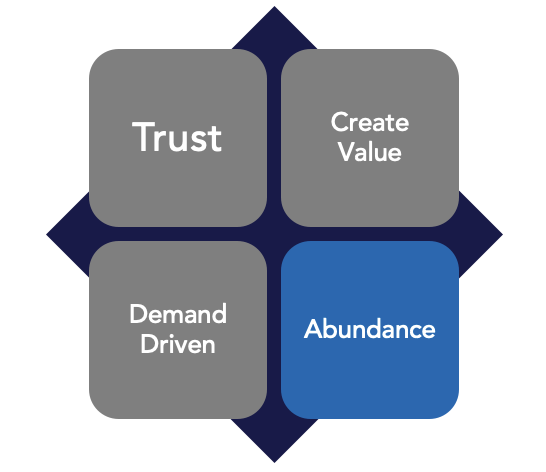Abundance
Share more, learn more.

“If you have an apple and I have an apple and we exchange these apples then you and I will still each have one apple. But if you have an idea and I have an idea and we exchange these ideas, then each of us will have two ideas.”
-George Bernard Shaw
Business models over the past hundred years have evolved based on a manufacturing mentality where the outcome or product is known and tangible: it is a physical thing that we can feel and touch. Tangible things are finite and therefore operate on a basis of scarcity. If I have an apple and you don’t, I can give it to you, in which case you have the apple and I don’t. Or, I can share the apple with you. I might give you half the apple, in which case we each get less than the whole apple. Knowledge is intangible, so it is not bound by the properties of scarcity. If I share an idea with you, I don’t have less of an idea than I did before I shared it with you. In fact, if I share an idea with you, you might offer another idea or perspective that enhances the idea and now we both have more than we started with.
Knowledge and Abundance
Knowledge operates on a principle of abundance; the more we share, the more we learn. Knowledge is the by-product of interactions or experiences, and no one leaves an interaction with less knowledge than they started with. Abundance is a powerful and disruptive principle for business.
Perhaps one of the most powerful examples of the idea "the more we share, the more we learn" is Wikipedia. In 1993, Microsoft introduced a digital encyclopedia called Encarta. They embraced scarcity principles with a traditional, tightly controlled publishing model and charged a fee to access it. Encarta shut down in 2009 because it was rendered irrelevant by Wikipedia. Wikipedia, founded in 2001, embraced abundance principles: open source and free to access. By the time it was shuttered, Encarta had about 62,000 articles accessible for a fee, while Wikipedia had 2.8 million articles accessible for free (6.5 million as of 2022).
Access to all this information comes with a responsibility for double-checking sources: since anyone can create or edit articles on Wikipedia, its accuracy has been called into question. A study from Oxford University showed quantitative results for the articles reviewed, that the Wikipedia articles in this sample scored higher overall than the comparison articles from other online encyclopedias with respect to "the accuracy, references, style/ readability and overall judgment”.
Another interesting dynamic to consider is the speed of updates or corrections. Encarta was updated every 6 months, while Wikipedia is updated instantly. On any given day between 1- 2 million articles are updated.
Innovation and Abundance
Another powerful benefit of embracing the principle of abundance is the relationship between diversity and innovation. The more diverse perspectives involved in problem-solving, the more innovative the resolution is likely to be. A great book by Frans Johansson called The Medici Effect explores this idea. While we might think that a small group of experts would be the best at solving new complex issues, the research shows otherwise. Creativity and innovation happen at the intersection of different perspectives. So having a diverse set of skills and experience, like generalists and specialists collaborating on problem-solving, proves to be the most effective approach.
Leadership Challenge
Contribution Assessment and Abundance
The principle of abundance has influenced the Consortium's thinking in the area of contribution assessment and recognition. The methodologies propose a shift from recognizing people's contributions based on activity measures to an assessment of value creation. Rather than assessing how busy people are, we want to assess who is creating value. For most organizations, there are numerous ways to create value, and success for the organization requires a diverse set of skills. Not everyone in the organization possesses all the skills required.
If we acknowledge that there are numerous skills required in creating value, we need to recognize individual competency and contribution in each of those skill areas. Recognition programs designed on the principle of abundance ensure peoples' strengths and talents are acknowledged based on their contribution.
We have an opportunity to recognize people for what they are good at based on their ability to create value, not based on a comparison with their peers. Most of our performance and recognition models are based on a model of scarcity. Glaring examples of this exist in the practices of stack ranking and leader boards. These practices inhibit collaboration and are often simplistic and limited in their view of contribution. There can only be one "number one" in these flawed models and they do not acknowledge the diverse ways people contribute to the organization's success.
A recognition model designed on the principle of abundance considers all the ways people can contribute, and recognition or distinction is criteria-based. The distinction for the highest level of contribution in any given area may be very hard to achieve, and therefore rare, but it is not limited to a single individual. If I meet the criteria, I earn the distinction. By recognizing the diverse ways people contribute, and acknowledging all who contribute at a high level, we encourage them to do more of it.
The shift from activity-based measures to outcome-based measures and creating a criteria-based recognition model that recognizes the numerous ways people contribute is not easy. This is a challenge for leadership.
Summary
We have to rethink our organizational practices and be more thoughtful about when the principle of scarcity makes sense and when the principle of abundance makes sense. This is not an either/or situation; it is an "and" situation. Organizations have to be good at each depending on the situation.
References
- Wikipedia Accuracy
- How Stack Ranking Corrupts Culture
- The Medici Effect by Frans Johansson

